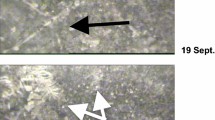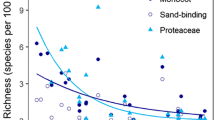Abstract
Species that inhabit phosphorus- (P) and micronutrient-impoverished soils typically have adaptations to enhance the acquisition of these nutrients, for example cluster roots in Proteaceae. However, there are several species co-occurring in the same environment that do not produce similar specialised roots. This study aims to investigate whether one of these species (Scholtzia involucrata) can benefit from the mobilisation of P or micronutrients by the cluster roots of co-occurring Banksia attenuata, and also to examine the response of B. attenuata to the presence of S. involucrata. We conducted a greenhouse experiment, using a replacement series design, where B. attenuata and S. involucrata shared a pot at proportions of 2:0, 1:2 and 0:4. S. involucrata plants grew more in length, were heavier and had higher manganese (Mn) concentrations in their young leaves when grown next to one individual of B. attenuata and one individual of S. involucrata than when grown with three conspecifics. All S. involucrata individuals were colonised by arbuscular mycorrhizal fungi, and possibly Rhizoctonia. Additionally, P concentration was higher in the young leaves of B. attenuata when grown with another B. attenuata than when grown with two individuals of S. involucrata, despite the smaller size of the S. involucrata individuals. Our results demonstrate that intraspecific competition was stronger than interspecific competition for S. involucrata, but not for B. attenuata. We conclude that cluster roots of B. attenuata facilitate the acquisition of nutrients by neighbouring shrubs by making P and Mn more available for their neighbours.






Similar content being viewed by others
References
Bertness MD, Callaway R (1994) Positive interactions in communities. Trends Ecol Evol 9:191–193
Callaway RM (2007) Positive interactions and interdependence in plant communities, 1st edn. Springer, Dordrecht
Chapman SK, Langley JA, Hart SC, Koch GW (2006) Plants actively control nitrogen cycling: uncorking the microbial bottleneck. New Phytol 169:27–34
Child R, Smith AN (1960) Manganese toxicity in Grevillea robusta. Nature 186:1067
Cu STT, Hutson J, Schuller KA (2005) Mixed culture of wheat (Triticum aestivum L.) with white lupin (Lupinus albus L.) improves the growth and phosphorus nutrition of the wheat. Plant Soil 272:143–151
Dinkelaker B, Römheld V, Marschner H (1989) Citric acid excretion and precipitation of calcium citrate in the rhizosphere of white lupin (Lupinus albus L.). Plant Cell Environ 12:285–292
Dinkelaker B, Hengeler C, Marschner H (1995) Distribution and function of proteoid roots and other root clusters. Bot Acta 108:193–200
Dinkelaker B, Hengeler G, Neumann G, Eltrop L, Marschner H (1997) Root exudates and mobilization of nutrients. In: Rennenberg H, Eschrich W, Ziegler H (eds) Trees—contributions to modern tree physiology. Backhuys, Leiden, pp 441–452
Epstein E, Bloom AJ (2005) Inorganic components of plants. In: Epstein E, Bloom AJ (eds) Mineral nutrition of plants: principles and perspectives, 2nd edn. Sinauer, Massachusetts, pp 41–66
Gardner WK, Boundy KA (1983) The acquisition of phosphorus by Lupinus albus L. IV. The effect of interplanting wheat and white lupin on the growth and mineral composition of the two species. Plant Soil 70:391–402
Gardner WK, Parbery DG, Barber DA (1982) The acquisition of phosphorus by Lupinus albus L. I. Some characteristics of the soil/root interface. Plant Soil 68:19–32
Gardner WK, Parbery DG, Barber DA, Swinden L (1983) The acquisition of phosphorus by Lupinus albus L. V. The diffusion of exudates away from roots: a computer simulation. Plant Soil 72:13–29
Grierson PF (1992) Organic acids in the rhizosphere of Banksia integrifolia L.f. Plant Soil 144:259–265
Grierson PF, Attiwill PM (1989) Chemical characteristics of the proteoid root mat of Banksia integrifolia L. Aust J Bot 37:137–143
Hopper SD (2009) OCBIL theory: towards an integrated understanding of the evolution, ecology and conservation of biodiversity on old, climatically buffered, infertile landscapes. Plant Soil 322:49–86
Hopper SD, Gioia P (2004) The Southwest Australian Floristic Region: evolution and conservation of a global hotspot of biodiversity. Annu Rev Ecol Evol S 35:623–650
Horst WJ, Waschkies C (1987) Phosphatversorgung von Sommerweizen (Triticum aestivum L.) in Mischkultur mit Weißer Lupine (Lupinus albus L.). Z Pflanzenern Bodenkd 150:1–8
Humphries JM, Stangoulis JCR, Graham RD (2007) Manganese. In: Barker AV (ed) Handbook of plant nutrition. CRC, Hoboken, pp 351–374
Laliberté E, Turner BL, Costes T, Pearse SJ, Wyrwoll K-H, Zemunik G, Lambers H (2012) Experimental assessment of nutrient limitation along a 2-million year dune chronosequence in the South-western Australia biodiversity hotspot. J Ecol 100:631–642
Lambers H, Shane MW, Cramer MD, Pearse SJ, Veneklaas EJ (2006) Root structure and functioning for efficient acquisition of phosphorus: matching morphological and physiological traits. Ann Bot 98:693–713
Lambers H, Raven JA, Shaver GR, Smith SE (2008) Plant nutrient-acquisition strategies change with soil age. Trends Ecol Evol 23:95–103
Lambers H, Brundrett MC, Raven JA, Hopper SD (2010) Plant mineral nutrition in ancient landscapes: high plant species diversity on infertile soils is linked to functional diversity for nutritional strategies. Plant Soil 334:11–31
Lambers H, Bishop JG, Hopper SD, Laliberté E, Zúñiga-Feest A (2012a) Phosphorus-mobilisation ecosystem engineering: the roles of cluster roots and carboxylate exudation in young P-limited ecosystems. Ann Bot 110:329–348
Lambers H, Cawthray GR, Giavalisco P, Kuo J, Laliberté E, Pearse SJ, Scheible W-R, Stitt M, Teste F, Turner BL (2012b) Proteaceae from severely phosphorus-impoverished soils extensively replace phospholipids with galactolipids and sulfolipids during leaf development to achieve a high photosynthetic phosphorus-use efficiency. New Phytol 196:1098–1108
Li H, Smith SE, Holloway RE, Zhu Y, Smith FA (2006) Arbuscular mycorrhizal fungi contribute to phosphorus uptake by wheat grown in a phosphorus-fixing soil even in the absence of positive growth responses. New Phytol 172:536–543
Li L, Li S-M, Sun J-H, Zhou L–L, Bao X-G, Zhang H-G, Zhang F-S (2007) Diversity enhances agricultural productivity via rhizosphere phosphorus facilitation on phosphorus-deficient soils. Proc Natl Acad Sci USA 104:11192–11196
McArthur WM, Johnston DAW, Snell LJ (1991) Reference soils of South-Western Australia. Deptartment of Agriculture, Western Australia on behalf of the Australian Society of Soil Science, Perth
Motomizu S, Wakimoto T, Toei K (1983) Spectrophotometric determination of phosphate in river waters with molybdate and malachite green. Analyst 108:361–367
Myers N, Mittermeier RA, Mittermeier CG, da Fonseca GAB, Kent J (2000) Biodiversity hotspots for conservation priorities. Nature 403:853–858
Neumann G, Martinoia E (2002) Cluster roots—an underground adaptation for survival in extreme environments. Trends Plant Sci 7:162–167
Parfitt R (1979) The availability of P from phosphate-goethite bridging complexes. Desorption and uptake by ryegrass. Plant Soil 53:55–65
Pate JS, Dell B (1984) Economy of mineral nutrients in sandplain species. In: Pate JS, Beard JS (eds) Kwongan. Plant life of the Sandplain. University of Western Australia Press, Nedlands
Pearse SJ, Veneklaas EJ, Cawthray GR, Bolland MDA, Lambers H (2006) Triticum aestivum shows a greater biomass response to a supply of aluminium phosphate than Lupinus albus, despite releasing fewer carboxylates into the rhizosphere. New Phytol 169:515–524
Pedas P, Husted S, Skytte K, Schjoerring JK (2011) Elevated phosphorus impedes manganese acquisition by barley plants. Front Plant Sci 2:37
Posta K, Marschner H, Römheld V (1994) Manganese reduction in the rhizosphere of mycorrhizal and non-mycorrhizal maize. Mycorrhiza 5:119–124
Prjanischnikow D (1934) Über das Aufschließen der Rohphosphate durch die Wurzelausscheidungen von Lupinen. Phosphorsäure 4:1–23
Raghothama KG (1999) Phosphate acquisition. Annu Rev Plant Physiol Plant Mol Biol 50:665–693
Richardson S, Peltzer D, Allen R, McGlone M, Parfitt R (2004) Rapid development of phosphorus limitation in temperate rainforest along the Franz Josef soil chronosequence. Oecologia 139:267–276
Roughgarden J (1979) Theory of population genetics and evolution ecology: an introduction, 1st edn. Macmillan, New York
Ryan MH, Angus JF (2003) Arbuscular mycorrhizae in wheat and field pea crops on a low P soil: increased Zn uptake but no increase of P uptake or yield. Plant Soil 250:225–239
Ryan MH, Tibbett M, Edmonds-Tibbett T, Suriyagoda LD, Lambers H, Cawthray GR, Pang J (2012) Carbon trading for phosphorus gain: the balance between rhizosphere carboxylates and mycorrhizal symbiosis in plant phosphorus acquisition. Plant Cell Environ 35:2170–2180
Shane MW, Lambers H (2005a) Cluster roots: a curiosity in context. Plant Soil 274:101–125
Shane MW, Lambers H (2005b) Manganese accumulation in leaves of Hakea prostrata (Proteaceae) and the significance of cluster roots for micronutrient uptake as dependent on phosphorus supply. Physiol Plant 124:441–450
Shane MW, De Vos M, De Roock S, Cawthray GR, Lambers H (2003) Effects of external phosphorus supply on internal phosphorus concentration and the initiation, growth and exudation of cluster roots in Hakea prostrata R.Br. Plant Soil 248:209–219
Specht RL, Specht A (1999) Australian plant communities: dynamics of structure, growth and biodiversity. Oxford University Press, South Melbourne
Tilman D (1982) Resource competition and community structure, 1st edn. Princeton University Press, Princeton
Twidale CR, Campbell EM (1988) Ancient Australia. GeoJournal 16:339–354
Vance CP, Uhde-Stone C, Allan DL (2003) Phosphorus acquisition and use: critical adaptations by plants for securing a nonrenewable resource. New Phytol 157:423–447
Walker TW, Syers JK (1976) The fate of phosphorus during pedogenesis. Geoderma 15:1–9
Wallace A (1984) Effect of phosphorus deficiency and copper excess on vegetative growth of bush bean plants in solution culture at two different solution pH levels. J Plant Nutr 7:603–608
Welch RM, Shuman L (1995) Micronutrient nutrition of plants. CRC Crit Rev Plant Sci 14:49–82
Acknowledgments
H. L. and E. J. V. were supported by the Australian Research Council (ARC). This research was also funded by the University of Western Australia. We are thankful to Stuart Pearse and Ricarda Jost for helping us with the nutrient analyses, to Michael Shane, Etienne Laliberté and François Teste for helpful discussions, to Ana Elena Muler and Mariana Cruz Campos for assistance with harvesting the plants, to Bruno A. Buzatto for all the help with the experiments, as well as with statistical analysis, and to Evonne Walker and to Megan Ryan for helping with the mycorrhizal colonisation analysis. Constructive comments from reviewers and the editor helped improve the manuscript.
Author information
Authors and Affiliations
Corresponding author
Additional information
Communicated by Hermann Heilmeier.
Rights and permissions
About this article
Cite this article
Muler, A.L., Oliveira, R.S., Lambers, H. et al. Does cluster-root activity benefit nutrient uptake and growth of co-existing species?. Oecologia 174, 23–31 (2014). https://doi.org/10.1007/s00442-013-2747-z
Received:
Accepted:
Published:
Issue Date:
DOI: https://doi.org/10.1007/s00442-013-2747-z




